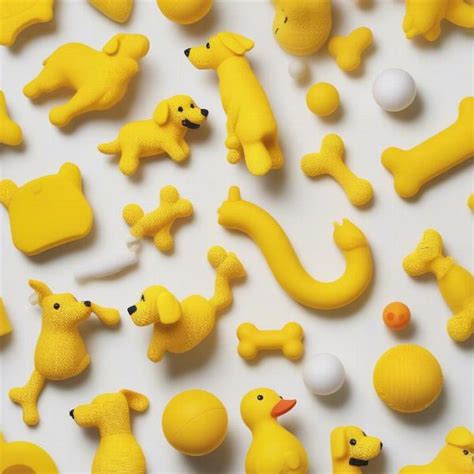Introduction:

Dogs, our beloved companions, deserve the best toys and activities to keep them happy and healthy. With the abundance of options available, it can be challenging to find the perfect toys that align with your dog’s unique needs and preferences. This comprehensive guide will delve into the world of dog toys and play types, providing you with all the essential information you need to make informed decisions.
Understanding Your Dog’s Play Styles
Every dog is unique in its play style, which can be influenced by factors such as breed, age, and personality. Identifying your dog’s preferred play style will help you select toys and activities that maximize their enjoyment and development.
1. Chewers: Chewing is a natural behavior for dogs, and it serves various purposes, including teething, stress relief, and boredom reduction. Providing chew toys made from durable materials, such as Nylabones or Kongs, can satisfy your dog’s chewing urges and protect your furniture from damage.
2. Fetchers: Fetching is a classic game that engages dogs’ natural prey drive and provides both physical and mental stimulation. Balls, frisbees, and sticks are all popular fetch toys. Choose toys that are appropriate for your dog’s size and strength to prevent injury.
3. Tuggers: Tug-of-war is a fun and interactive game that strengthens your bond with your dog while providing mental and physical stimulation. Use tug toys made from strong materials, such as rope or fleece, and ensure that you control the game to prevent your dog from becoming overly aggressive.
4. Nurturers: Some dogs enjoy cuddling and nurturing objects. Soft toys, such as plush animals or blankets, can provide comfort and a sense of security. These toys are especially beneficial for dogs who experience anxiety or separation issues.
Choosing the Right Toys
With the vast array of dog toys available, selecting the right ones can be overwhelming. Here are some tips to guide your decision-making:
Consider your dog’s age and size: Puppies have different needs than adult dogs, and larger dogs require more durable toys than smaller ones.
Observe your dog’s play style: Identify your dog’s preferred play type and choose toys that cater to their specific interests.
Look for durability: Toys should be made from high-quality materials that can withstand your dog’s chewing and playing habits.
Provide variety: Offer a range of toys to keep your dog engaged and prevent boredom.
Avoid dangerous toys: Avoid toys with sharp edges or small parts that can be swallowed or pose a choking hazard.
Seek professional advice: If you’re unsure which toys are best for your dog, consult with your veterinarian or a professional dog trainer for guidance.
Different Types of Play
Beyond choosing toys, it’s crucial to understand the various types of play that are essential for your dog’s well-being:
1. Physical play: This includes activities such as fetch, chase, and tug-of-war. Physical play provides exercise, improves muscle development, and releases energy.
2. Mental play: Mental play stimulates your dog’s cognitive abilities and can help prevent boredom. Puzzles, interactive toys, and training games are great ways to engage your dog’s mind.
3. Social play: Dogs are social creatures, and playing with other dogs helps them develop critical social skills. Dog parks, playdates, and organized activities provide opportunities for dogs to interact and socialize.
4. Independent play: Independent play allows your dog to entertain themselves with toys or activities without your direct involvement. This is important for promoting self-reliance and preventing separation anxiety.
5. Cooperative play: Cooperative play involves working together with your dog towards a common goal, such as agility or search-and-rescue activities. This type of play strengthens the bond between you and your dog while developing their problem-solving skills.
Tips for Enriching Playtime
To maximize the benefits of playtime, consider the following tips:
Establish a dedicated play area: Create a safe and comfortable space where your dog can play freely without distractions.
Start with short play sessions: Gradually increase the duration of play sessions as your dog adapts to the activity.
Vary play activities: Mix up the types of play to keep your dog engaged and stimulated.
Supervise playtime: Especially for puppies or dogs who are prone to chewing or destructive behavior.
Reward your dog: Offer treats or praise to reinforce positive play behaviors and encourage your dog to continue playing.
Monitor your dog’s comfort: Pay attention to your dog’s body language and stop playtime if they show signs of discomfort or fatigue.
Conclusion
Choosing the right dog toys and understanding the different types of play is essential for providing your furry friend with a happy and fulfilling life. By considering your dog’s individual needs and preferences, you can select toys that stimulate their minds, engage their bodies, and strengthen your bond. Remember that play is a crucial part of your dog’s health and well-being, and it should be a joyful and rewarding experience for both you and your companion.
## Additional Resources
* [American Kennel Club: Dog Toys and Play](https://www.akc.org/expert-advice/lifestyle/everything-you-need-to-know-about-dog-toys/)
* [PetMD: The Importance of Play for Dogs](https://www.petmd.com/dog/behavior/evr_multi_importance_play_dogs)
* [ASPCA: How to Play with Your Dog](https://www.aspca.org/pet-care/dog-care/how-play-your-dog)





















